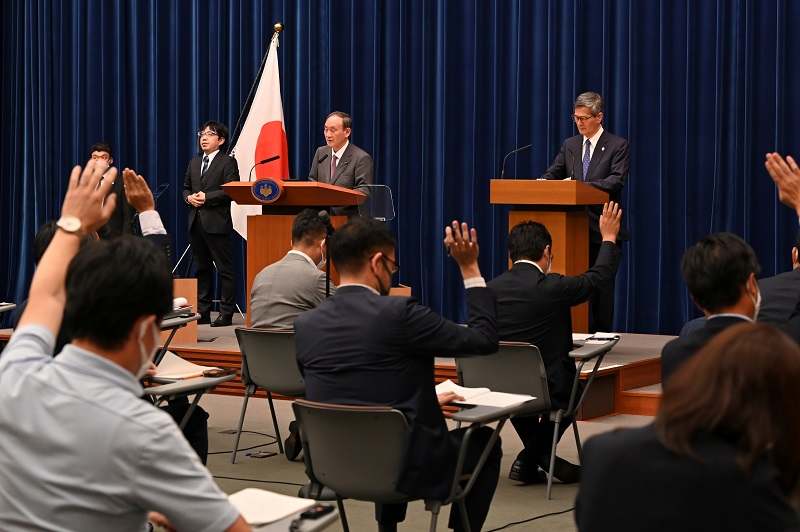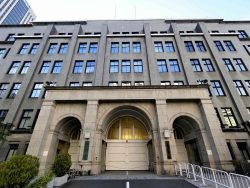Former deputy chief cabinet secretary: Dominance of Prime Minister’s Office weakened ministries, agencies

Japan’s Prime Minister Yoshihide Suga attends a news conference with Shigeru Omi, chairman of the government’s pandemic advisory panel, at the prime minister’s office, amid the coronavirus disease (COVID-19) pandemic, in Tokyo, Japan August 25, 2021.
12:27 JST, August 30, 2021
Bureaucrats in Tokyo’s Kasumigaseki district have fought diligently day and night to deal with the novel coronavirus pandemic, but there have also been conspicuous problems, including organizational bottlenecks, declining morale and scandals.
Twenty years have passed since the central government’s ministries and agencies were reorganized in 2001. How has Kasumigaseki changed? The Yomiuri Shimbun spoke with former Deputy Chief Cabinet Secretary Teijiro Furukawa about the challenges Kasumigaseki will face and how it should develop in the future.
Reorganization
As part of the administrative reforms led by then Prime Minister Ryutaro Hashimoto, the headquarters to promote the reorganization of the central government ministries and agencies were set up in June 1998. I still remember saying, in my capacity as deputy chief cabinet secretary, that the reforms could not be toothless. I sternly told the bureaucrats [who had been assigned to the headquarters], “Those who intend to work on behalf of the ministries and agencies they came from will be sent back to their old offices right away.”
The government ministries and agencies were to be reorganized primarily because the environment surrounding public administration had greatly changed. During the postwar period of rapid economic growth, Kasumigaseki’s major task was to distribute the fruits [of economic growth] appropriately. Those were placid days when politicians and the public did not meddle with the details.
As the Cold War ended and the nation’s bubble economy collapsed, however, Kasumigaseki could not properly deal with changing times any longer, and politicians came to the fore.
With our society becoming ever more complex and diversified, it was necessary to eliminate bureaucratic sectionalism and swiftly respond to these changes in an integrated manner. Reforms to strengthen the functions of the Cabinet and boost the prime minister’s leadership were the natural course of events.
Twenty years have passed since then, and there have been benefits in terms of political leadership. There are also problems, however, when you consider the reforms, including their implementation.
Since the second Cabinet led by Prime Minister Shinzo Abe, it seemed that the Prime Minister’s Office controlled the personnel management of bureaucrats at ministries and agencies, including the Finance Ministry, thanks to the establishment of the Cabinet Bureau of Personnel Affairs. It even seemed to control the budget compilations of the ministries and agencies.
It can probably be said that since then, the Cabinet has been characterized by the “unipolar dominance of the Prime Minister’s Office,” with the power of the Finance Ministry thoroughly weakened.
Too many in control
The problem with the present Cabinet under Prime Minister Yoshihide Suga is that the chief cabinet secretary, who is supposed to play a pivotal role in the Prime Minister’s Office, does not seem to be at the center of things amid the COVID-19 pandemic. The key point of crisis control is a clear chain of command and system for taking responsibility.
There seem to be too many skippers onboard this ship: Taro Kono, the minister in charge of administrative and regulatory reforms, is in charge of vaccines, while Yasutoshi Nishimura, the economic revitalization minister, is handling measures to cope with the novel coronavirus in cooperation with Norihisa Tamura, the minister of health, labor and welfare.
There are also notable inconsistencies in the dissemination of relevant information by the Cabinet.
It was envisaged under the administrative reforms led by Hashimoto that while the Prime Minister’s Office leads the Cabinet like a control tower, each ministry and agency has its own state ministers and parliamentary vice ministers, who are assisted by bureaucrats, and moves political initiatives forward.
The philosophy pursued under the Hashimoto administrative reforms slightly differs from the unipolar dominance of the Prime Minister’s Office. The leadership of the Prime Minister’s Office is accepted as natural, but the Cabinet cannot sufficiently function as a whole unless each ministry and agency is also allowed to wield its own power.
Under the Hashimoto administrative reforms, the scheme was to reduce the number of ministries and agencies by half. The number was the focus, and not enough discussion was conducted as to the amount of administrative work at each ministry and agency.
Work increased explosively
The former Health and Welfare Ministry and the former Labor Ministry were integrated into the present Health, Labor and Welfare Ministry, chiefly to respond to changes in the times. For instance, issues involving elderly people, such as pensions, health care, and nursing care, needed to be considered not in isolation but together with matters concerning work styles.
This philosophy was correct, but the amount of administrative work exploded. The prescribed number of staff at the ministry is not at all suited to the workload.
In response to the COVID-19 pandemic, the ministry’s inadequate preparation against infectious diseases has been criticized, including securing hospital beds and vaccines. As previous border-control measures against such diseases had functioned well, the ministry had scaled back other elements of the system, including the public health centers.
Amid these circumstances, the nation was hit by the rapid spread of infections with the novel coronavirus, sending the ministry into turmoil over how to respond to the situation. This immediately spurred discussions about the proper form of the ministry and the idea of splitting it up. First, however, it is necessary to put its systems in good order, including the number of personnel.
In contrast, the Cabinet Office and the Cabinet Secretariat have swollen more than initially expected. If a political initiative is to be carried out, they tend to quickly set up an organization, such as a body in charge, at the Cabinet Office and the Cabinet Secretariat. As a consequence, ministries and agencies that have to assign their staff members to these new organizations take on an extra burden.
Needs change in keeping with the times. Organizations that have achieved a certain purpose should be reviewed. Politicians are reluctant to reorganize entities set up in the Cabinet Office because the public is likely to interpret such moves as the government not having paid enough attention to relevant measures.
On this 20th anniversary of the administrative reforms, it would be advisable to reexamine what has accumulated like sediment.
What the present Kasumigaseki lacks is mettle, to put it briefly. Final decisions are made by politicians, but in the process, bureaucrats need to assist them as a group of experts. Politics may go in the wrong direction. In such cases, bureaucrats have to muster their courage and advise politicians.
Bureaucrats are not subcontractors for politicians. Politics only functions well with excellent bureaucrats. Lately, young people have increasingly been shying away from taking up public service jobs, an extremely worrisome situation. It is urgent to develop an environment in which bureaucrats can tackle their work with high morale.

Teijiro Furukawa, former Deputy Chief Cabinet Secretary
Furukawa, 86, was born in Saga Prefecture. He joined the then Health and Welfare Ministry (currently the Health, Labor and Welfare Ministry) in 1960. After serving as an administrative vice minister, he assumed the post of deputy chief cabinet secretary in 1995. For the following eight years and seven months, he served in cabinets led by prime ministers Tomiichi Murayama, Ryutaro Hashimoto, Keizo Obuchi, Yoshiro Mori, and Junichiro Koizumi.
"Politics" POPULAR ARTICLE
-

Japan to Support Central Asian Logistics Route That Bypasses Russia, Plan to Be Part of Upcoming Summit in Tokyo
-

Japan to Tighten Screening of Foreigners’ Residential Status by Providing Information of Nonpayment of Taxes
-

Chinese, Russian Bombers Flew Unusual Path by Heading Toward Tokyo; Move Likely Meant to Intimidate Japan
-

Japan Plans National Database to Track Foreign Ownership of Real Estate, Land as It Weighs New Rules
-

Up to 199,000 Deaths Estimated From Mega-Tsunami; Most Recent Occurrence Took Place in 17th Century
JN ACCESS RANKING
-

Tokyo Economic Security Forum to Hold Inaugural Meeting Amid Tense Global Environment
-

Keidanren Chairman Yoshinobu Tsutsui Visits Kashiwazaki-Kariwa Nuclear Power Plant; Inspects New Emergency Safety System
-

Imports of Rare Earths from China Facing Delays, May Be Caused by Deterioration of Japan-China Relations
-

University of Tokyo Professor Discusses Japanese Economic Security in Interview Ahead of Forum
-

Japan Pulls out of Vietnam Nuclear Project, Complicating Hanoi’s Power Plans
























